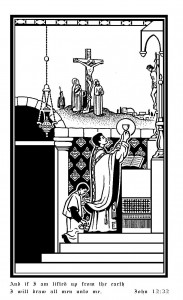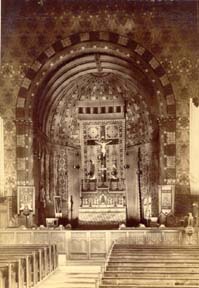Our Long History and Tradition…

The Order dates back to 1877, when the first local Guild of St. Vincent was formed at St. Clement’s Church in Philadelphia (on the left), where the acolytes joined together in prayer, study, and training as a part of their service at God’s altar.
 The Order was officially founded on the Feast of Vincent of Saragossa (22 January), 1915 at the Church of the Advent, Boston to serve Anglicans/Episcopalians in all of the North American countries. There, the Purpose, Objects, and Rule of Life were adopted by the Council of Governors consisting of clergy and laity with an advising Bishop.
The Order was officially founded on the Feast of Vincent of Saragossa (22 January), 1915 at the Church of the Advent, Boston to serve Anglicans/Episcopalians in all of the North American countries. There, the Purpose, Objects, and Rule of Life were adopted by the Council of Governors consisting of clergy and laity with an advising Bishop.
 The Order of St. Vincent’s 1915 original logo is on the right. – John 12:32 (and I, when I am lifted up from the earth, will draw all men to myself.) is found on the bottom part of the logo.
The Order of St. Vincent’s 1915 original logo is on the right. – John 12:32 (and I, when I am lifted up from the earth, will draw all men to myself.) is found on the bottom part of the logo.
In 1939, the O.S.V. affiliated with the Scottish and British acolyte guilds. This affiliation brought acolytes throughout the Anglican Communion into fellowship with and prayer for one another. In 1970, the Order opened membership to girls and women, and to all lay ministers involved in sacred service in 1979. The Governors voted in 1984 to continue affiliation with the newly formed “continuing” Anglican bodies and to, by word and example, call all Catholic Communions to visible and comprehensive unity. We are now truly a trans-Catholic order.
Today…
 There are parish Chapters in almost every state in the U. S. and around the world. New Chapters are forming every month. The Order should not be considered an organization just for children… on the contrary, the OSV embraces all ages and crosses generations. Passing down liturgical knowledge and our rich traditional heritage is our joy through teaching, guidance, inspiration, and example. The OSV produces educational tracts and manuals to help make this possible. We also foster fellowship by promoting activities among members outside the sanctuary, some educational and others for sheer enjoyment and recreation. Many OSV Chapters have become the beginnings of parish youth groups (EYC) which often lead to social service in the church and the community.
There are parish Chapters in almost every state in the U. S. and around the world. New Chapters are forming every month. The Order should not be considered an organization just for children… on the contrary, the OSV embraces all ages and crosses generations. Passing down liturgical knowledge and our rich traditional heritage is our joy through teaching, guidance, inspiration, and example. The OSV produces educational tracts and manuals to help make this possible. We also foster fellowship by promoting activities among members outside the sanctuary, some educational and others for sheer enjoyment and recreation. Many OSV Chapters have become the beginnings of parish youth groups (EYC) which often lead to social service in the church and the community.
The OSV teaches the concept of a “stairway of lay ministry” which can begin as early as ten years old and extends throughout our lives. Children can start as candle or boat bearers with simple sanctuary duties, and as they learn and mature, grow into more complicated and responsible roles such as sacristans, readers, chalice bearers, trainers, teachers, or other important positions. Involvement in church liturgies and activities need not end with high-school graduation.
Saint Vincent of Saragossa
Deacon and Martyr
St. Vincent, a Deacon of the Spanish Church, was born at Saragossa, and martyred at Valencia, 303 A.D. during the Diocletian persecution, the tenth and last, at about the same time that St. Alban, the first martyr of the British Church, suffered in England. Renowned as a preacher, glorified by the severity of his sufferings, and praised for the fortitude with which he bore them, he is especially remembered for his humility, in that, as a Deacon, the lowest order of the ordained ministry, he served his bishop faithfully.
 St. Vincent is one of the few martyrs in the famous fourth century of martyrdom whose acts are quite authentic and documented. They may be traced to a contemporaneous age.
St. Vincent is one of the few martyrs in the famous fourth century of martyrdom whose acts are quite authentic and documented. They may be traced to a contemporaneous age.
In art, he is young, mild and handsome: is vested as a Deacon in traditional dalmatic, bearing a palm branch (of victory) and a smoking thurible. The instrument of his torture is a grid-iron on which his salt-besprinkled body was burned, and broken pottery over which his body was dragged. Usually near him is perched a crow or raven, symbolic of the restlessness of the saints in the world.
His relics are at Valencia Spain. St. Vincent’s feast day is January 22nd

